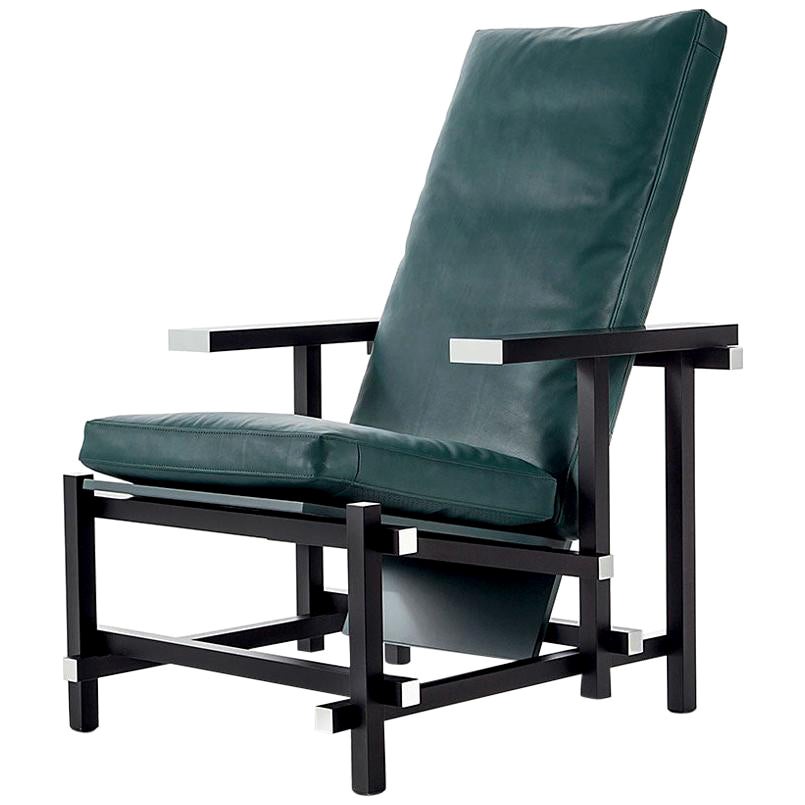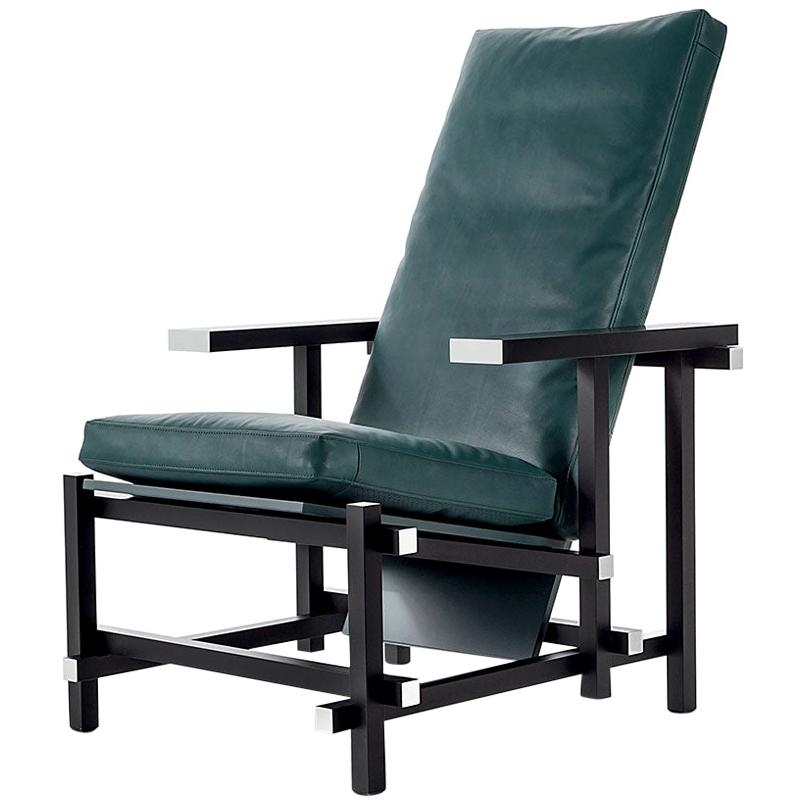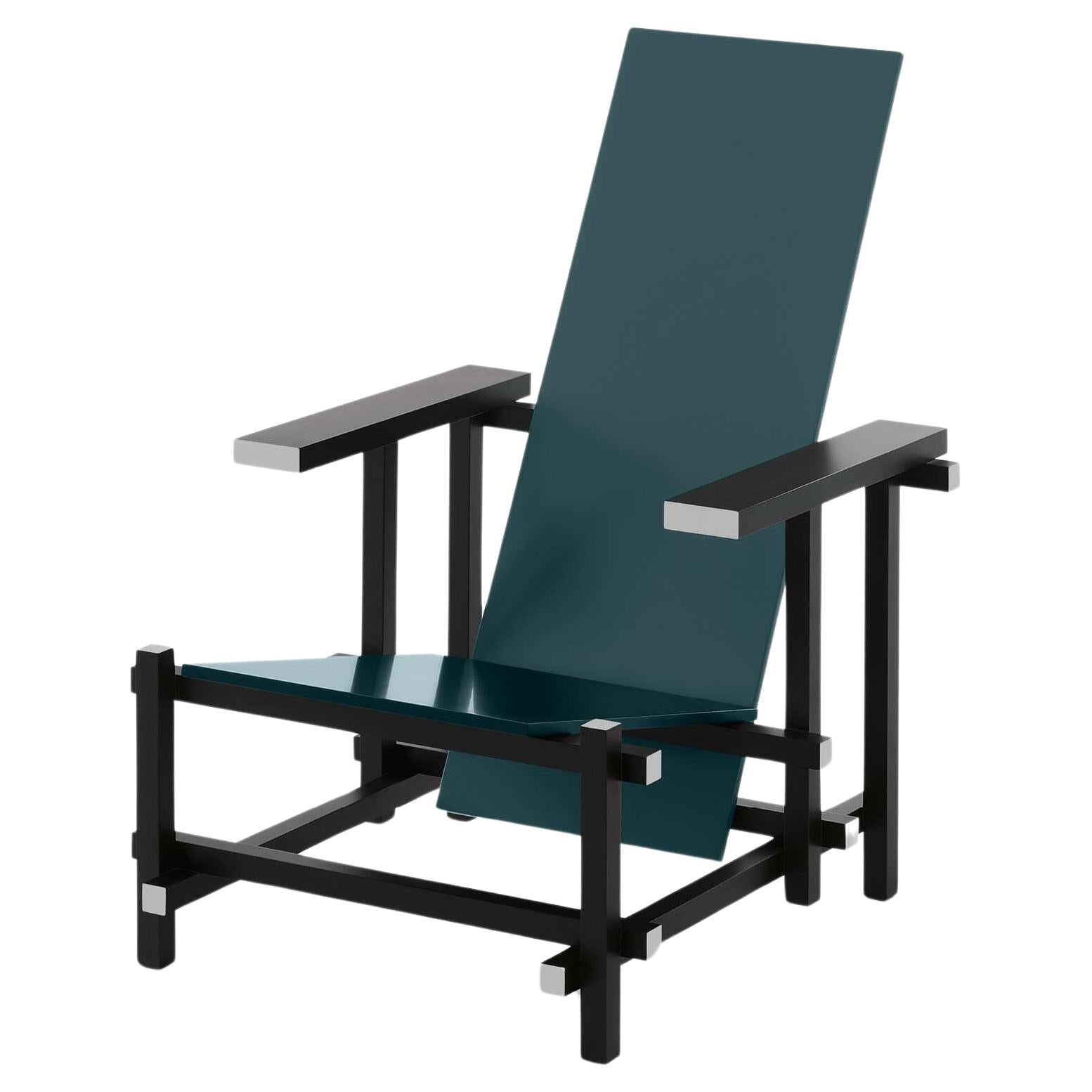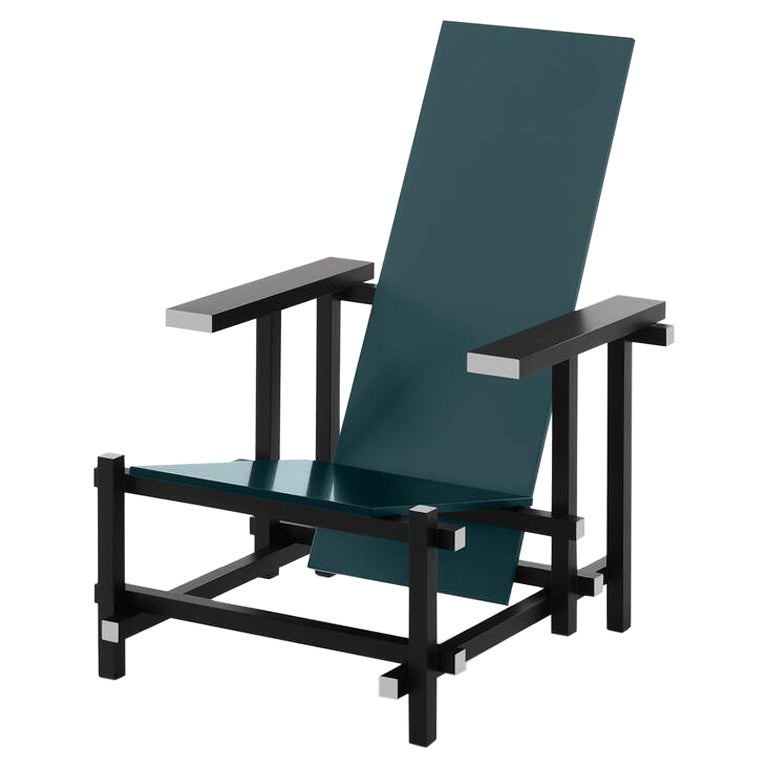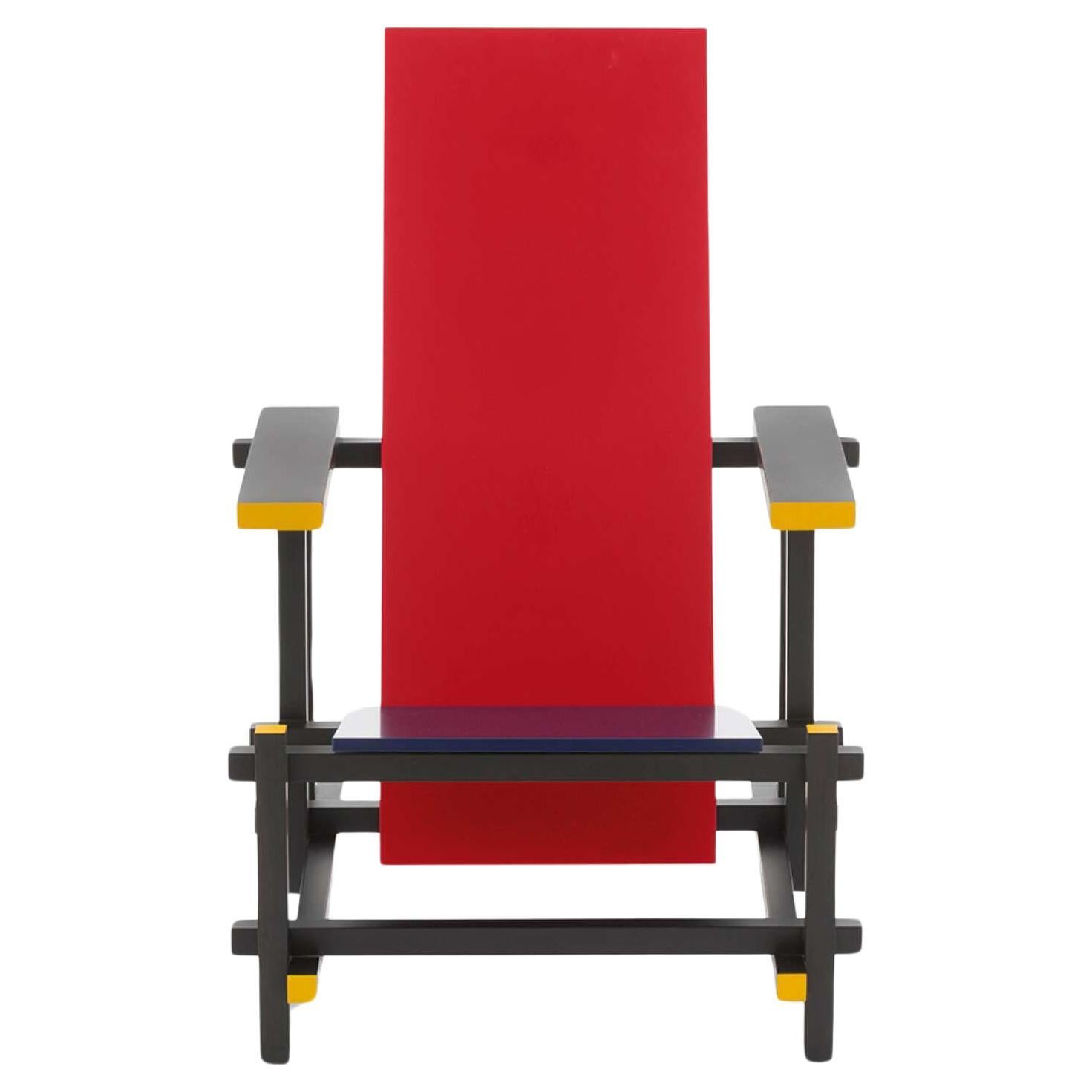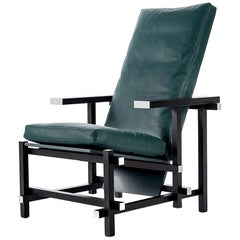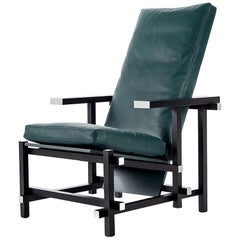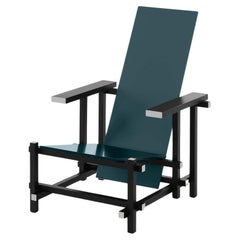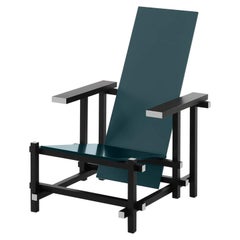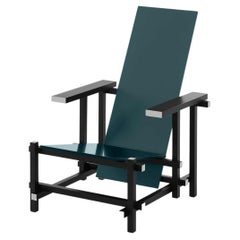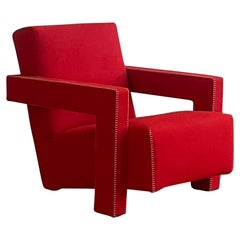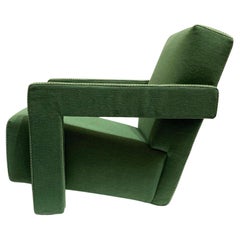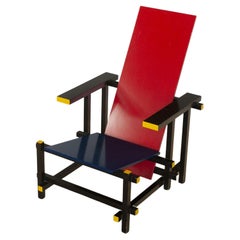Items Similar to Gerrit Thomas Rietveld Black Red And Blue Armchair For Cassina
Want more images or videos?
Request additional images or videos from the seller
1 of 13
Gerrit Thomas Rietveld Black Red And Blue Armchair For Cassina
$8,542.90per item
$10,678.62per item20% Off
£6,349.70per item
£7,937.12per item20% Off
€7,176per item
€8,970per item20% Off
CA$11,795.39per item
CA$14,744.24per item20% Off
A$13,080.22per item
A$16,350.27per item20% Off
CHF 6,872.68per item
CHF 8,590.85per item20% Off
MX$159,818.02per item
MX$199,772.53per item20% Off
NOK 85,986.65per item
NOK 107,483.31per item20% Off
SEK 80,713.16per item
SEK 100,891.45per item20% Off
DKK 54,641.65per item
DKK 68,302.06per item20% Off
Quantity
About the Item
Gerrit Thomas Rietveld Black Red And Blue Armchair For Cassina
A variation of the iconic 1918 chair by G. T. Rietveld, the Black Red and Blue wood armchair grew out of the Dutch master’s unflagging exploration and the clear evolution of the archetypal model with a view to the exploration of color.
Lounge chair withframe in black-stained beechwood with white
contrasting parts. Seat and back in green lacquered multiplywood.
The armchair can have a single seat and backrest cushion in fabric or
leather. This chair, produced for the school teacher Wicher Zeilmaker,
is one of the numerous versions of the iconic model designed in 1918.
After analysing the original pieces, it was discovered that the first
was completely produced in unpainted wood. In the following years
Rietveld proposed various examples, monochrome or painted with
other colours, depending on the clients necessities and the interiors
that the chair would furnish. The first owners kept the chair in their
homes as if it were an abstract sculpture but in some cases it was
used as a proper chair, with cushions to make it more comfortable
Structure
· In black-stained beechwood
with white contrasting parts.
Seat and back
· On green lacquered multiplywood.
The armchair can have a single seat
and backrest cushion in fabric or
leather
One of the versions of the iconic model dated 1918. The structure is in black-stained beechwood with white contrasting parts. Seat and back in green lacquered multiplywood. The armchair can have a single seat and backrest cushion in fabric or leather.
The Black Red and Blue (Zeilmaker version) born from Rietveld’s chromatic experimentation
While researching the origins of the Red and Blue model in collaboration with the Rietveld heirs, it emerged that the key idea of the first prototypes was based on the concept of spatial organisation expressed through the monochrome tones of its elements. The first version was in fact produced in 1918 in completely unpainted wood. In the following years Rietveld proposed various examples, either monochrome or painted in different colours, depending on the requirements of his customers and the interiors for which the chairs were intended. As such, it comes as no surprise to find this 1920s version, presented as part of Cassina’s MutAzioni selection, created for the school teacher Wicher Zeilmaker with a black frame with white ends and a dark green painted seat and backrest. It was Rietveld’s ever-increasing involvement in the De Stijl movement that led him to also use primary colours on this model in 1923, and as such the chair became a veritable manifesto for the emerging neoplastic movement. Initially dubbed Slat chair, Rietveld only gave it the name Red and Blue in the 1950s following its chromatic evolution. The various owners of the different examples used the chair as an abstract- realist sculpture in their interiors and, in some cases, as a simple tool for sitting on, adding cushions to make it more comfortable, just like Cassina offers for the Black Red and Blue today.
Important information regarding images of products:
Please note that some of the images show other colors and variations of the model, these images are only to present interior design proposals. The item that is selling is on the first image.
Important information regarding color(s) of products:
Actual colors may vary. This is due to the fact that every computer monitor, laptop, tablet and phone screen has a different capability to display colors and that everyone sees these colors differently. We try to edit our photos to show all of our products as life-like as possible, but please understand the actual color may vary slightly from your monitor.
About the Designer:
Gerrit Thomas Rietveld, born in Utrecht on 24 June 1888, seems possessed of two personalities, each so distinct that one might take his work to be that of more than one artist. The first personality is that seen in the craftsman cabinet-maker working in a primordial idiom, re-inventing chairs and other furniture as if no one had ever built them before him and following a structural code all of his own; the second is that of the architect working with elegant formulas, determined to drive home the rationalist and neoplastic message in the context of European architecture. The two activities alternate, overlap, and fuse in a perfect osmosis unfolding then into a logical sequence. In 1918 Rietveld joined the “De Stijl” movement which had sprung up around the review of that name founded the year before by Theo van Doesburg. The group assimilated and translated into ideology certain laws on the dynamic breakdown of compositions (carrying them to an extreme) that had already been expressed in painting by the cubists: the “De Stijl” artists also carefully studied the architectonic lesson taught by the great Frank Lloyd Wright, whose influence was widely felt in Europe at that time.Collaborating first with Robert van’t Hoff and Vilmos Huszar, then with Theo van Doesburg and Cornelius van Eesteren, Rietveld soon became one of the most distinguished interpreters of the neoplastic message.Among his most important works are:the Schröder house at Utrecht (1924); the “Row Houses” at Utrecht (1931-34); the Dutch pavilion at the Venice Biennial (1954); the sculpture pavilion in the Rijksmuseum Kröller-Müller at Otterloo and the Van Gogh Museum in Amsterdam (1955). Out of his equally important furniture, Cassina has chosen for its own production: the “Red and Blue” (1918), the “Zig-Zag” (1934), the “Schröder 1” (1923), the “Utrecht” (1935)
About Manufacture:
Established in 1927 by Cesare and Umberto Cassina in Meda, Italy, Cassina launched industrial design in Italy in the 1950s, based on a totally innovative approach that marked the transition from artisan production to mass production. With a mindset focused on research and innovation, Cassina combines technology and long-standing artisan craftsmanship.
Memory, research, innovation. Cassina blends traditional skills and superior productivity, meticulous attention to detail and passion, uniqueness and experimentation, wellbeing and sustainability. Today, the company continues to address new lifestyles with the creation of complete, harmonious interior decor solutions that embody the best contemporary design for all areas of the home.
- Dimensions:Height: 34.65 in (88 cm)Width: 17.33 in (44 cm)Depth: 32.68 in (83 cm)Seat Height: 13 in (33 cm)
- Style:Mid-Century Modern (In the Style Of)
- Materials and Techniques:
- Place of Origin:
- Period:
- Date of Manufacture:Contemporary
- Production Type:New & Custom(Current Production)
- Estimated Production Time:14-15 weeks
- Condition:
- Seller Location:Barcelona, ES
- Reference Number:1stDibs: LU1427243174392
About the Seller
4.9
Platinum Seller
Premium sellers with a 4.7+ rating and 24-hour response times
Established in 2015
1stDibs seller since 2015
1,889 sales on 1stDibs
Typical response time: 12 hours
- ShippingRetrieving quote...Shipping from: Barcelona, Spain
- Return Policy
Authenticity Guarantee
In the unlikely event there’s an issue with an item’s authenticity, contact us within 1 year for a full refund. DetailsMoney-Back Guarantee
If your item is not as described, is damaged in transit, or does not arrive, contact us within 7 days for a full refund. Details24-Hour Cancellation
You have a 24-hour grace period in which to reconsider your purchase, with no questions asked.Vetted Professional Sellers
Our world-class sellers must adhere to strict standards for service and quality, maintaining the integrity of our listings.Price-Match Guarantee
If you find that a seller listed the same item for a lower price elsewhere, we’ll match it.Trusted Global Delivery
Our best-in-class carrier network provides specialized shipping options worldwide, including custom delivery.More From This Seller
View AllGerrit Rietveld Zeilmaker Version of Black Red and Blue Chair by Cassina
By Cassina, Gerrit Rietveld
Located in Barcelona, Barcelona
Chair designed by Gerrit Rietveld in 1920. Relaunched in 2015.
Manufactured by Cassina in Italy.
One of the versions of the iconic model dated 1918. The structure is in black-stained beechwood with white contrasting parts. Seat and back in green lacquered multiplywood. The armchair can have a single seat and backrest cushion in fabric or leather.
The black red and blue (Zeilmaker version) born from Rietveld’s chromatic experimentation
While researching the origins of the red and blue model in collaboration with the Rietveld heirs, it emerged that the key idea of the first prototypes was based on the concept of spatial organization expressed through the monochrome tones of its elements. The first version was in fact produced in 1918 in completely unpainted wood.
In the following years Rietveld proposed various examples, either monochrome or painted in different colors, depending on the requirements of his customers and the interiors for which the chairs were intended. As such, it comes as no surprise to find this 1920s version, presented as part of Cassina’s MutAzioni selection, created for the school teacher Wicher Zeilmaker with a black frame with white ends and a dark green painted seat and backrest.
It was Rietveld’s ever-increasing involvement in the De Stijl movement that led him to also use primary colors on this model in 1923, and as such the chair became a veritable manifesto for the emerging neoplastic movement. Initially dubbed slat chair, Rietveld only gave it the name red and blue in the 1950s following its chromatic evolution.
The various owners of the different examples used the chair as an abstract-realist sculpture in their interiors and, in some cases, as a simple tool for sitting on, adding cushions to make it more comfortable, just like Cassina offers for the black red and blue today.
Important information regarding images of products:
Please note that some of the images show other colors and variations of the model, these images are only to present interior design proposals. The item that is selling is on the first image.
Important information regarding color(s) of products:
Actual colors may vary. This is due to the fact that every computer monitor, laptop, tablet and phone screen has a different capability to display colors and that everyone sees these colors differently. We try to edit our photos to show all of our products as life-like as possible, but please understand the actual color may vary slightly from your monitor
About the designer:
Gerrit Thomas Rietveld, born in Utrecht on 24 June 1888, seems possessed of two personalities, each so distinct that one might take his work to be that of more than one artist. The first personality is that seen in the craftsman cabinet-maker working in a primordial idiom, re-inventing chairs and other furniture as if no one had ever built them before him and following a structural code all of his own; the second is that of the architect working with elegant formulas, determined to drive home the rationalist and neoplastic message in the context of European architecture. The two activities alternate, overlap, and fuse in a perfect osmosis unfolding then into a logical sequence. In 1918 Rietveld joined the “De Stijl” movement which had sprung up around the review of that name founded the year before by Theo van Doesburg. The group assimilated and translated into ideology certain laws on the dynamic breakdown of compositions (carrying them to an extreme) that had already been expressed in painting by the cubists: the “De Stijl” artists also carefully studied the architectonic lesson taught by the great Frank Lloyd Wright, whose influence was widely felt in Europe at that time.
Collaborating first with Robert van’t Hoff and Vilmos Huszar...
Category
2010s Italian Mid-Century Modern Armchairs
Materials
Leather, Wood
Gerrit Rietveld Zeilmaker Version of Black Red and Blue Chair by Cassina
By Cassina, Gerrit Rietveld
Located in Barcelona, Barcelona
Chair designed by Gerrit Rietveld in 1920. Relaunched in 2015.
Manufactured by Cassina in Italy.
One of the versions of the iconic model dated 1918. The structure is in black-stained beechwood with white contrasting parts. Seat and back in green lacquered multiplywood. The armchair can have a single seat and backrest cushion in fabric or leather.
The black red and blue (Zeilmaker version) born from Rietveld’s chromatic experimentation
While researching the origins of the red and blue model in collaboration with the Rietveld heirs, it emerged that the key idea of the first prototypes was based on the concept of spatial organization expressed through the monochrome tones of its elements. The first version was in fact produced in 1918 in completely unpainted wood.
In the following years Rietveld proposed various examples, either monochrome or painted in different colors, depending on the requirements of his customers and the interiors for which the chairs were intended. As such, it comes as no surprise to find this 1920s version, presented as part of Cassina’s MutAzioni selection, created for the school teacher Wicher Zeilmaker with a black frame with white ends and a dark green painted seat and backrest.
It was Rietveld’s ever-increasing involvement in the De Stijl movement that led him to also use primary colors on this model in 1923, and as such the chair became a veritable manifesto for the emerging neoplastic movement. Initially dubbed slat chair, Rietveld only gave it the name red and blue in the 1950s following its chromatic evolution.
The various owners of the different examples used the chair as an abstract-realist sculpture in their interiors and, in some cases, as a simple tool for sitting on, adding cushions to make it more comfortable, just like Cassina offers for the black red and blue today.
Production delay:
8-9 weeks
Important information regarding images of products:
Please note that some of the images show other colors and variations of the model, these images are only to present interior design proposals. The item that is selling is on the first image.
Important information regarding color(s) of products:
Actual colors may vary. This is due to the fact that every computer monitor, laptop, tablet and phone screen has a different capability to display colors and that everyone sees these colors differently. We try to edit our photos to show all of our products as life-like as possible, but please understand the actual color may vary slightly from your monitor
About the designer:
Gerrit Thomas Rietveld, born in Utrecht on 24 June 1888, seems possessed of two personalities, each so distinct that one might take his work to be that of more than one artist. The first personality is that seen in the craftsman cabinet-maker working in a primordial idiom, re-inventing chairs and other furniture as if no one had ever built them before him and following a structural code all of his own; the second is that of the architect working with elegant formulas, determined to drive home the rationalist and neoplastic message in the context of European architecture. The two activities alternate, overlap, and fuse in a perfect osmosis unfolding then into a logical sequence. In 1918 Rietveld joined the “De Stijl” movement which had sprung up around the review of that name founded the year before by Theo van Doesburg. The group assimilated and translated into ideology certain laws on the dynamic breakdown of compositions (carrying them to an extreme) that had already been expressed in painting by the cubists: the “De Stijl” artists also carefully studied the architectonic lesson taught by the great Frank Lloyd Wright, whose influence was widely felt in Europe at that time.
Collaborating first with Robert van’t Hoff and Vilmos Huszar, then with Theo van Doesburg and Cornelius van Eesteren, Rietveld soon became one of the most distinguished interpreters of the neoplastic message.
Among his most important works are:
the Schröder house at Utrecht (1924); the “Row Houses” at Utrecht (1931-1934); the Dutch pavilion at the Venice Biennial (1954); the sculpture pavilion in the Rijksmuseum Kröller-Müller at Otterloo and the Van Gogh Museum in Amsterdam (1955). Out of his equally important furniture, Cassina has chosen for its own production: the “Red and Blue” (1918), the “Zig-Zag” (1934), the “Schröder 1...
Category
2010s Italian Mid-Century Modern Armchairs
Materials
Leather, Wood
$7,142 Sale Price / item
20% Off
Gerrit Thomas Rietveld Black Red And Blue Armchair For Cassina
Located in Barcelona, Barcelona
Gerrit Thomas Rietveld Black Red And Blue Armchair For Cassina
A variation of the iconic 1918 chair by G. T. Rietveld, the Black Red and Blue wood armchair grew out of the Dutch mas...
Category
2010s Italian Mid-Century Modern Armchairs
Materials
Lacquer
$6,371 Sale Price / item
20% Off
Gerrit Rietveld Zeilmaker Version of Black Red and Blue Chair by Cassina
By Gerrit Rietveld, Cassina
Located in Barcelona, Barcelona
Chair designed by Gerrit Rietveld in 1920. Relaunched in 2015.
Manufactured by Cassina in Italy.
One of the versions of the iconic model dated 1918. The structure is in black-stained beechwood with white contrasting parts. Seat and back in green lacquered multiplywood.
The black red and blue (Zeilmaker version) born from Rietveld’s chromatic experimentation
While researching the origins of the red and blue model in collaboration with the Rietveld heirs, it emerged that the key idea of the first prototypes was based on the concept of spatial organization expressed through the monochrome tones of its elements. The first version was in fact produced in 1918 in completely unpainted wood.
In the following years Rietveld proposed various examples, either monochrome or painted in different colors, depending on the requirements of his customers and the interiors for which the chairs were intended. As such, it comes as no surprise to find this 1920s version, presented as part of Cassina’s MutAzioni selection, created for the school teacher Wicher Zeilmaker with a black frame with white ends and a dark green painted seat and backrest.
It was Rietveld’s ever-increasing involvement in the De Stijl movement that led him to also use primary colors on this model in 1923, and as such the chair became a veritable manifesto for the emerging neoplastic movement. Initially dubbed slat chair, Rietveld only gave it the name red and blue in the 1950s following its chromatic evolution.
The various owners of the different examples used the chair as an abstract-realist sculpture in their interiors and, in some cases, as a simple tool for sitting on, adding cushions to make it more comfortable, just like Cassina offers for the black red and blue today.
Important information regarding images of products:
Please note that some of the images show other colors and variations of the model, these images are only to present interior design proposals. The item that is selling is on the first image.
Important information regarding color(s) of products:
Actual colors may vary. This is due to the fact that every computer monitor, laptop, tablet and phone screen has a different capability to display colors and that everyone sees these colors differently. We try to edit our photos to show all of our products as life-like as possible, but please understand the actual color may vary slightly from your monitor
About the designer:
Gerrit Thomas Rietveld, born in Utrecht on 24 June 1888, seems possessed of two personalities, each so distinct that one might take his work to be that of more than one artist. The first personality is that seen in the craftsman cabinet-maker working in a primordial idiom, re-inventing chairs and other furniture as if no one had ever built them before him and following a structural code all of his own; the second is that of the architect working with elegant formulas, determined to drive home the rationalist and neoplastic message in the context of European architecture. The two activities alternate, overlap, and fuse in a perfect osmosis unfolding then into a logical sequence. In 1918 Rietveld joined the “De Stijl” movement which had sprung up around the review of that name founded the year before by Theo van Doesburg. The group assimilated and translated into ideology certain laws on the dynamic breakdown of compositions (carrying them to an extreme) that had already been expressed in painting by the cubists: the “De Stijl” artists also carefully studied the architectonic lesson taught by the great Frank Lloyd Wright, whose influence was widely felt in Europe at that time.
Collaborating first with Robert van’t Hoff and Vilmos Huszar, then with Theo van Doesburg and Cornelius van Eesteren, Rietveld soon became one of the most distinguished interpreters of the neoplastic message.
Among his most important works are:
the Schröder house at Utrecht (1924); the “Row Houses” at Utrecht (1931-1934); the Dutch pavilion at the Venice Biennial (1954); the sculpture pavilion in the Rijksmuseum Kröller-Müller at Otterloo and the Van Gogh Museum in Amsterdam (1955). Out of his equally important furniture, Cassina has chosen for its own production: the “Red and Blue” (1918), the “Zig-Zag” (1934), the “Schröder 1...
Category
2010s Italian Mid-Century Modern Armchairs
Materials
Leather, Wood
Gerrit Rietveld Zeilmaker Version of Black Red and Blue Chair by Cassina
By Gerrit Rietveld, Cassina
Located in Barcelona, Barcelona
Chair designed by Gerrit Rietveld in 1920. Relaunched in 2015.
Manufactured by Cassina in Italy.
One of the versions of the iconic model dated 1918. The structure is in black-stained beechwood with white contrasting parts. Seat and back in green lacquered multiplywood.
The black red and blue (Zeilmaker version) born from Rietveld’s chromatic experimentation
While researching the origins of the red and blue model in collaboration with the Rietveld heirs, it emerged that the key idea of the first prototypes was based on the concept of spatial organization expressed through the monochrome tones of its elements. The first version was in fact produced in 1918 in completely unpainted wood.
In the following years Rietveld proposed various examples, either monochrome or painted in different colors, depending on the requirements of his customers and the interiors for which the chairs were intended. As such, it comes as no surprise to find this 1920s version, presented as part of Cassina’s MutAzioni selection, created for the school teacher Wicher Zeilmaker with a black frame with white ends and a dark green painted seat and backrest.
It was Rietveld’s ever-increasing involvement in the De Stijl movement that led him to also use primary colors on this model in 1923, and as such the chair became a veritable manifesto for the emerging neoplastic movement. Initially dubbed slat chair, Rietveld only gave it the name red and blue in the 1950s following its chromatic evolution.
The various owners of the different examples used the chair as an abstract-realist sculpture in their interiors and, in some cases, as a simple tool for sitting on, adding cushions to make it more comfortable, just like Cassina offers for the black red and blue today.
Important information regarding images of products:
Please note that some of the images show other colors and variations of the model, these images are only to present interior design proposals. The item that is selling is on the first image.
Important information regarding color(s) of products:
Actual colors may vary. This is due to the fact that every computer monitor, laptop, tablet and phone screen has a different capability to display colors and that everyone sees these colors differently. We try to edit our photos to show all of our products as life-like as possible, but please understand the actual color may vary slightly from your monitor
About the designer:
Gerrit Thomas Rietveld, born in Utrecht on 24 June 1888, seems possessed of two personalities, each so distinct that one might take his work to be that of more than one artist. The first personality is that seen in the craftsman cabinet...
Category
2010s Italian Mid-Century Modern Armchairs
Materials
Leather, Wood
Gerrit Thomas Rietveld Red And Blue Armchair For Cassina
Located in Barcelona, Barcelona
Gerrit Thomas Rietveld Red And Blue Armchair For Cassina
Designed by Rietveld in 1918, Red & Blue is a design armchair in the guise of a Rationalist geometric sculpture. A genuine m...
Category
2010s Italian Mid-Century Modern Armchairs
Materials
Beech
$5,457 Sale Price / item
20% Off
You May Also Like
Gerrit Rietveld Zeilmaker Version of Black Red and Blue for Cassina, Italy new
By Cassina, Gerrit Rietveld
Located in Berlin, DE
Prices vary dependent on the size/model and material of the product. Chair designed by Gerrit Rietveld in 1920. Relaunched in 2015. Manufactured by Cassina in Italy. One of the versi...
Category
21st Century and Contemporary Italian Chairs
Materials
Wood, Leather
Gerrit Thomas Rietveld "Utrecht" Armchair for Cassina, 1935
By Gerrit Rietveld, Cassina
Located in Lonigo, Veneto
Gerrit Thomas Rietveld "Utrecht" armchairs for Cassina, wool and steel, Netherlands, 1935.
The designer came up with the idea of the “Utrecht” armchair in 1935 while working for t...
Category
Vintage 1980s Dutch Mid-Century Modern Armchairs
Materials
Wool
Gerrit Thomas Rietveld Utrecht Armchair in Linen by Cassina
By Cassina
Located in Sag Harbor, NY
This modern classic armchair is a sophisticated combination of style and comfort. Featuring iconic design elements by Dutch designer Gerrit Tho...
Category
2010s Italian Armchairs
Materials
Linen
Gerrit Thomas Rietveld Red and Blu Chair for Cassina
By Gerrit Rietveld, Cassina
Located in bari, IT
A world icon of neo-plasticist design this chair armchair called Rood Blauwe (Red and Blue) by its Dutch designer Gerrit Thomas Rietveld, Cassina production in the 1960s.
Category
Mid-20th Century Italian Mid-Century Modern Club Chairs
Materials
Beech
$3,523 Sale Price
20% Off
Contemporary Slipper Chair of Generous Proportions
By Gerrit Rietveld, Cassina
Located in New York, NY
Building on his earlier, iconic designs - the 1920s De stijl Red Blue chair and his Zig Zag chair from the 1930s - Rietveld designed the Utrecht chair with an added degree of comfort...
Category
21st Century and Contemporary European Side Chairs
Materials
Upholstery, Giltwood, Lacquer
Charlotte Perriand 533 Doron Hotel Armchair for Cassina, Italy - new
By Charlotte Perriand, Cassina
Located in Berlin, DE
Prices vary dependent on the color and material. Charlotte Perriand 533 Doron Hotel Armchair. Available in American Walnut, black stained ash wo...
Category
21st Century and Contemporary Italian Mid-Century Modern Chairs
Materials
Fur, Wood
More Ways To Browse
Dutch Seating Company
Thomas Toner
Green Industrial Cabinet
A Schroder
Mid Century Wood Slats Lounge Chair
Green Cassina Chaired
Dutch Artist Black And White
Rietveld Zig Zag
Gerrit Rietveld Zig Zag
Rietveld Zig Zag Chair
Wood Zig Zag Chair
Thomas Holland Sculpture
Theo Van Doesburg
Cubist Cabinet
Gerrit Thomas Rietveld Zig Zag Chair
Cassina Zig Zag Chair
Schroder House
Dutch Cushion Cabinet
